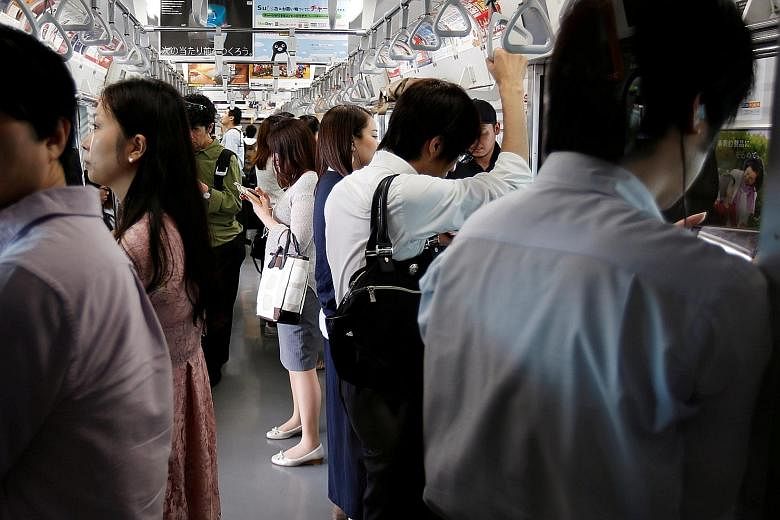Japan's train services are arguably best known for two things: their punctuality and the oshiya or pushers who cram commuters into sardine-packed trains during rush hours so that the doors can close and trains can depart the station.
A train operator in Tokyo even apologised to commuters for a service that departed 20 seconds ahead of schedule last November.
But the first-ever report on morning rush hour train delays of at least five minutes in the Greater Tokyo region tells quite a different story for fiscal year 2016.
The region is the most populated metropolitan area in the world, with nearly 38 million residents.
The Railway Bureau of the Ministry of Land, Infrastructure, Transport and Tourism surveyed 45 lines that serve Tokyo and connect the capital to neighbouring prefectures, such as Chiba, Saitama and Kanagawa. It found that train delays had occurred on at least 10 of 20 working days per month on 29 of these lines in fiscal year 2016, said the report released in December.
Most of the delays on the 45 Tokyo lines were minor ones that lasted between five and 10 minutes. Major delays of at least 30 minutes occurred on less than one work day in a month on 35 of the lines. The top cause of such delays was suicide.
The JR Chuo-Sobu line reported the most delays - an average of 19.1 business days per month. Of these, delays of between 10 and 30 minutes occurred on almost 10 days, minor delays on about eight days, and major delays on two days.
The line, a key east-west rail link, runs at about three-minute intervals during the morning peak. It connects Mitaka in the west to Chiba in the east, passing through major residential areas like Kichijoji and Hachioji with stops at Akihabara, the electronics hub, and Shinjuku, the world's busiest train station.
-
Lines with the most delays
-
JR CHUO-SOBU LINE
Connects Mitaka in the west to Chiba in the east, through Akihabara and Shinjuku
Delays of:
• Five to 10 minutes: 7.8 work days
• 10 to 30 minutes: 9.5 work days
• Above 30 minutes: 1.7 work days
(Total: 19.1 work days)
-
TOKYO METRO CHIYODA LINE
Connects Yoyogi-Uehara to Ayase, through Kasumigaseki and Hibiya
Delays of:
• Five to 10 minutes: 8.3 work days
• 10 to 30 minutes: 9.1 work days
• Above 30 minutes: 0.9 work day
(Total: 18.4 work days)
-
JR UTSUNOMIYA LINE
Connects Ueno to Nasushiobara in Tochigi prefecture, through Saitama prefecture
Delays of:
• Five to 10 minutes: 6.3 work days
• 10 to 30 minutes: 9.7 work days
• Above 30 minutes: 2.5 work days
(Total: 18.4 work days)
Numbers may not add up due to rounding off
The Tokyo Metro, which runs nine subway lines, reported delays of between seven and 18 working days a month on average.
Ms Shoko Yoshihara, a research fellow at Tokyo Foundation, told The Straits Times that the root causes go beyond "a mere scheduling or service management issue".
Train services, she said, are buckling under heavy demand.
Statistics show that the 20 most congested lines in the Greater Tokyo area are running at above 170 per cent capacity.
According to the transport ministry, a congestion rate of 150 per cent means that while commuters' shoulders may touch, they still have enough space to read a newspaper. At 180 per cent, papers must be folded to be read.
Indeed, 94 per cent of the minor delays were blamed on "external" factors. Half of these were due to trains departing later than scheduled as commuters were taking too long to board. Some 16 per cent were caused by train doors being unable to shut properly due to the interference of foreign objects.
Ms Yoshihara is unconvinced the measures by train companies - such as scheduling more trains and installing platform doors - will go a long way in reducing train delays or breakdowns. "Many workers are making long commutes of two hours or more to go to work by 9am every day," she said.
"And they will continue to force themselves into trains" unless there is a major tilt in the demand for train services by measures like flexi-work schemes that can allow staggered hours, she added.
Accountant Hiyoshi Takahashi, 37, who commutes 1½ hours to get to work by 9am, said he found delays of already crowded trains "really quite an annoyance".
But he saw a silver lining. "Once you get to central Tokyo, there are so many train lines that even if one service is down, there are many other options to consider."

